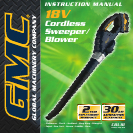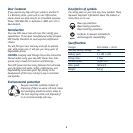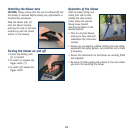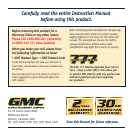6
• Check for alignment of moving parts, binding of moving
parts, breakage of parts, mounting, and any other
conditions that may affect it’s operation. A tube or
other part that is damaged should be properly repaired
or replaced by an authorised service agent.
• Use only spare parts and accessories recommended by
the manufacturer.
• Do not try to repair the tool or access internal parts.
Contact authorised service centres only.
• Do not get distracted and always concentrate on what
you are doing. Use common sense. Never operate the
tool when you are tired, sick or under the influence of
alcohol or other drugs.
• Keep a balanced and stable stance while using the tool.
• Do not operate this appliance with long loose hair or
loose fitting jewellery. Tie long loose hair back and
remove loose fitting jewellery.
• Do not use the blower on gravel surfaces.
Additional safety rules for the charger
• Before using the charger, read all the instructions and
cautionary markings on the charger and battery pack as
well as the instructions on using the battery pack.
• Only charge your batteries indoors as the charger is
designed for indoor use only.
• DANGER. If the battery pack is cracked or damaged in
any other way, do not insert it in the charger. There is a
danger of electric shock or electrocution.
• WARNING. Do not allow any liquid to come into contact
with the charger. There is a danger of electric shock.
• To allow the battery pack to cool down after charging,
do not place it in a hot environment such as a metal
shed or open trailer left in the sun.
• Recharge only with the charger specified by the
manufacturer. A charger that is suitable for one type of
battery pack may create a risk of fire when used with
another battery pack.
• The charger and battery packs supplied with it are
specifically designed to work together. Do not attempt
to charge the battery pack with any other charger than
the one supplied.
• Do not place any object on top of the charger as it
could cause overheating. Do not place the charger near
any heat source.
• Do not pull on the lead of the charger to disconnect it
from the power source.
• Make sure that the charger cable is positioned where
it will not be stepped on, tripped over or otherwise
subjected to damage or stress.
• Do not use an extension cord unless it is absolutely
necessary. The use of an improper extension cord could
cause the risk of fire, electric shock or electrocution.
• Do not use the charger if it has been subjected to a
heavy knock, dropped or otherwise damaged in any
way. Take the charger to an authorised service centre for
a check or repair.
• Do not disassemble the charger. Take it to an authorised
service centre when service or repair is required.
Incorrect re-assembly may result in the risk of fire,
electric shock or electrocution.
• To reduce the risk of an electric shock, unplug the
charger from the power supply before attempting to
clean it. Removing the battery alone does not reduce
the risk.
• Never attempt to connect two chargers together.
• Do not store or use the tool and battery pack in
locations where the temperature may reach or exceed
104°F (40°C) such as alongside sheds or metal
structures in the summer.
• The charger is designed for use from a standard
household electrical supply (230–240 volts). Do not
attempt to connect the charger to a supply with a
different supply.














